In the nine hundred years from A.D. 600 to 1500 ships developed from the Viking galleys of the Scandinavian shores to the caravels of Columbus and other famous navigators. In many ways this period was the most adventurous in maritime history
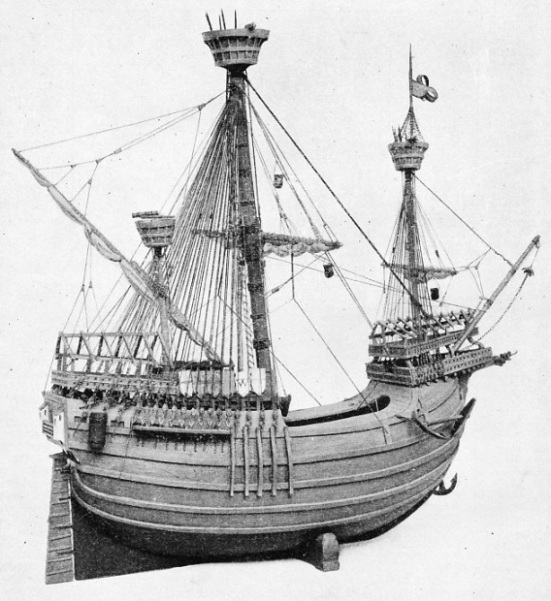
A RIGGED MODEL OF A FIFTEENTH CENTURY FLEMISH CARRACK made by R Morton Nance. The hull is carvel-built and is strengthened by wales or ridges on either side. The vertical skids on the carrack’s side are for protection when lying alongside wharves during loading or unloading. A squaresail is carried on the foremast, while on the mizenmast is a lateen sail.
IT was well said, centuries ago, that the first shipwright produced a ship that was no better than a bird without any feathers. Such a vessel could certainly float but had not the power to use wind. The primitive dug-out boat restricted all adventure to the confines of lake, river or neighbouring bays. Not until some sort of sail was invented could our early ancestors begin to explore. No man can paddle a craft through every hour of even a summer’s day, but two or three men can keep on for weeks running before the breeze, provided food and drinking water suffice.
Of the rough dug-outs fashioned from trees there is evidence enough to show that these were being used 4,000 years ago in the British Isles. Numerous examples of such simple boats have been unearthed and afford most interesting details. At Burpham, in Sussex, on the River Arun, for instance, a dug-out boat was discovered containing a one-armed anchor of yew wood. In 1886, while excavations were being made at Brigg (Lincolnshire), a similar boat was discovered measuring 47½ feet long, 4¼ feet wide and less than 3 feet deep. It had been fashioned from a single straight oak tree trunk. To keep out the splashing sea, a wash strake was fastened by a line of holes at the boat’s upper edge, and here we have the rude beginnings of building, as opposed to mere hollowing out. This Brigg boat is now preserved in a museum at Hull (Yorks). Other finds were made during 1924 and 1925 in Kent and Breconshire.
Across the North Sea along the Scandinavian coast with its innumerable islands, narrow channels and long fjords, there existed every inducement for going afloat. The rock scratchings at Bohuslan, near Gothenburg, indicate no fewer than forty types of craft - from a tree trunk to a vessel big enough to carry a hundred men. The date of these scratchings is at least 700 B.C., and some authorities assign the period to a date as early as 1110 B.C.
Thus seafaring of sorts is one of the oldest North European, occupations, but the Pacific Islanders, long before the white man ever reached the Pacific, had been enabled by the regular trade winds to make quite long voyages in canoes fashioned from hard logs, with a gunwale or topside sewn on by coco-nut fibre. A second canoe was added to the first and joined by a slender bridge, thus forming the catamaran. By making a kind of lugsail out of coco-nut fibre, it became possible to make ocean passages from island to island. In such a manner it was possible for the Hawaiians to reach Tahiti, some 2,400 miles away.
As. to navigation, the most primitive people are the keenest observers of natural phenomena and amass considerable knowledge about weather, seasons, currents and stars. They had no compasses, yet the steady trade wind gave them their course, and they reckoned their latitude by the simplest form of sextant. They used a calabash with holes in it and, having found the angle that the North Star made with the horizon, they compared the result with the known angle of their home port. Elizabethan navigators, and even uneducated sailing - ship masters of the early nineteenth century employed similar methods when finding their way about the trackless ocean.
Technical Excellence
If we take the years from A.D. 600 to 1500 as covering the Middle Ages, we shall find a time when, by trial and error, by experiment and failure, a sailing vessel with multiple masts, yards and sails, gradually emerged big enough to cross oceans, and deep-bellied enough to carry scores of people with their sustenance. By the dawn of the sixteenth century everything was ripe for world discovery, the effulgence of Elizabethan seafaring, and the foundation of European navies.
The hardy mariners who lived round the Scandinavian and Baltic shores built fine double-ended ships. Some of these have been unearthed during the last hundred years at such places as Nydam (north-east of Flensburg), and Sande Fjord, near Oslo. They were in a wonderful state of preservation because the Norsemen associated life after death with a boat journey (as did also the Egyptians) and were often buried in their ships. The Nydam ship was clinker-built, with a sharp stem and stern, and was 73 feet long and 10 ft. 10 in. wide. Built of oak, fastened by large iron nails, this third-century craft was fitted for twenty-eight oars and steered by an oar-rudder 9 ft. 7 in. long. In a clinker-built ship the planks forming the ship’s sides are overlapping. A ship whose planks are flush is carvel-built.
The Gokstad ship discovered in 1880 near Sande Fjord lay concealed beneath a mound some 18 feet above sea-level, and her almost perfect condition is attributed to the preservative qualities of blue clay. Her length is just under 80 feet, with a depth of 6 to 8½ feet, and she displaces about twenty tons. She stepped a mast with one huge squaresail, when this was lowered the propulsion was effected by thirty-two oars. The design of this remarkable hull is technically excellent, the underwater portion being particularly suited for reducing resistance. Beauty of lines and symmetrical proportions show how brilliant were Norse naval architects of about the year 800. That she had been a first-class ship at sea was abundantly proved, for at the end of the nineteenth century an exact replica was built and sailed across the Atlantic to be shown at the Chicago Exhibition. Her captain was enthusiastic in his praises. Later still, in 1903, another Viking ship was unearthed at Oseberg, on the western side of Oslo Fjord.
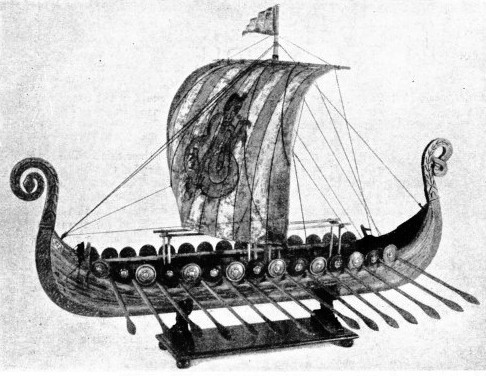
THE VIKING SHIP, found in 1903 at Oseberg, near Oslo, Norway, is shown in this photograph of a model. The ship dates from the middle of the ninth century and is 70½ feet long, with a beam of 16 ft. 9 in. and a depth of more than 5 feet. The galley was propelled by fifteen oars a side, which passed through oar-ports on either side. The mast was stepped almost amidships.
We can visualize these first northern ocean ships coming over the Atlantic in the long swell, their sails of white canvas striped with red, blue, green and yellow, but sometimes all purple, with gilded sterns, a marvellous sight when sailing in squadrons. The famous English epic, Beowulf, which is so rich in accurate picturesque detail, has for its background the shores of Sweden and Denmark. The poet refers to these single-sailed vessels with awe and reverence, and well suggests the chill of grey waters, the cry of sea-birds wheeling about the “foamy-necked” bows, the mast that “towered high”, on which was “a sea-garment, a sail made fast with ropes”. Even for another thousand years the expression “clothing the mast” was generally used for setting sail.
The Norsemen voyaged in these open double-enders to places as distant as Novaya Zemlya and Spitsbergen, to Iceland, Greenland and North America, 500 years before Columbus.
They were well acquainted with the Scandinavian coastline and had become brilliant in seamanship. To aid navigation, they had the rising and setting of the sun and the Pole Star. On board they carried a number of ravens which were released when land was suspected to be near; by following the direction of these birds a distant shore could be anticipated. Bad mistakes were inevitable, as, for example, when Thorstein Ericson set out from Greenland bound for America and arrived in Iceland. By the year 1267, if not earlier, they endeavoured to calculate the sun’s altitude by observing where the shadow of the gunwale fell on a man lying athwartships, when the sun was in the south.
The Norsemen were helped by the flight of wild fowl, as they differentiated the particular species of sea-birds when off the coasts of Scotland, Iceland or Ireland. They sighted whales, drift-ice, icebergs, floating seaweed or the purer blue of the warm Gulf Stream. In shallowing depths they used the sounding-lead. The last-mentioned operation was known as “probing the waves”.
If these noble and courageous ships, whose design has left a permanent influence on the shape of our lifeboats, by their pioneer voyaging completely altered the existing ideas of geography, it was only by compelling their hardy crews to live roughly. At sea they were exposed to cold and wet, with a bit of awning or “tilt” under which to crawl. In sheltered anchorages a Y-shaped “tilt” was spread over the entire ship. Food was carried in casks. No ship’s cook could be carried, but one man was chosen from day to day by lot to act in that capacity.
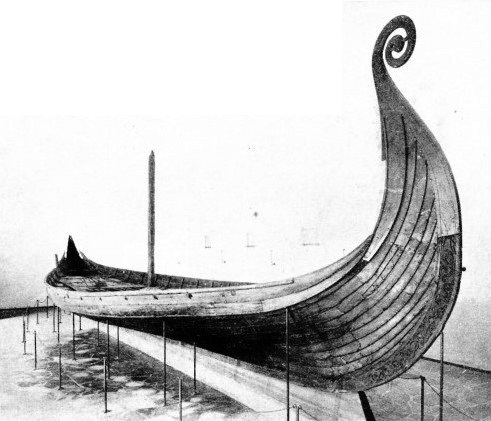
CLINKER-BUILT HULL of the Oseberg ship, discovered intact and now preserved in Oslo. The planks are secured together with nails, and overlap one another in this method of building. The planks are bound to the ribs by lashings passing through lugs or clamps.
The heaviest task happened when sail had to be lowered and oars relied upon. Each rower had about three and a half feet in which to work, but their benches did not stretch right across the vessel; otherwise the mobility of the fighting men would have been restricted. The commanding officer certainly had some sort of bed aft, and his own “meat-board” or mess-table. Before the ship went into battle, the mast was lowered by its forestay. Sails were made of home-spun until flax came to be cultivated. Reef points were affixed for shortening sail in bad weather, and overlapping shields protected rowers from spray and from arrows.
These vessels had small raised decks at- the bows and the stern. At the stern the captain kept also the ship’s arsenal, and forward of the central space for the oarsmen were stationed the picked warriors for defending the stem Normally the ships returned home about the autumnal equinox, when they were hauled ashore over rollers till winter melted into spring.
Gradually, as the years sped by and more voyaging was made in northern Europe, the need for bigger tonnage grew. The experience gained by transporting warriors to the Crusades or pilgrims to visit Palestine and the opening up of Mediterranean trade influenced the coming of the three-master, with a more full-bodied and rounded hull. By the end of the thirteenth century Genoese merchantmen were sailing up the English Channel, and our forefathers did not fail to profit by much that could be learned from Mediterranean construction. So the Viking type of large open boats passed away into little ships of 240 tons and less, with the rudder, placed aft as it remains to-day, instead of a steering oar on the starboard side, as the Norsemen had instituted. Light partitions, which could be easily rigged or taken down, were also introduced as cabins for the new cargo ships.
The more extended trade with the Low Countries, Denmark, Germany, Scandinavia, the Iberian Peninsula and southern France gave a great encouragement to the creation of better ships. The sea was the route to wealth.
From this realization there grew up collaterally increased piracy and the responsibility for keeping the trade routes safe. Nautical terminology became enriched in the thirteenth century by the importation of such words as “admiral”, first introduced to the Mediterranean by the ancient Arab mariners.
Such annual expeditions as that of the wine fleet from Bordeaux to England under the care of English admirals were some of the earliest instances of medieval convoys. A code of sea laws, primarily as instructions for an admiral in the governance of his fleet, gradually expanded to regulate such matters as the wages of seamen, prize money, punishment of offences at sea, and reimbursement for collisions. English literature of the fourteenth century provides a few illuminative glimpses of contemporary seafaring. We read of the sailors overhauling their gear, hoisting the “crossayl”, heaving up anchor by means of the windlass, climbing aloft by the backstays to let go the gaskets that kept sail to yard, so that now “the grete cloth falles”, and the mainsail is set. The “lodezmon” (leadsman, or pilot) stands by to guide the ship out of harbour, and the crew are busy trimming sails.
The poet Chaucer describes a west-country skipper from Dartmouth who wore a gown of coarse cloth as low as his knees and carried a dagger on a lanyard round his neck. Tanned by the summer sunshine, he was “a good felawe”, who enjoyed a draught of Bordeaux wine stolen while the wine-merchant was on board asleep; yet this mariner knew all about tides and pilotage from the Baltic right away to Spain. Many a tempest had shaken this shipmaster’s beard. It was Chaucer, too, who left the two-part, unfinished treatise on that navigational instrument called the astrolabe, for finding the sun’s altitude. The author of Le Morte d’Arthur, too, gives us a rich tapestry of bustling mariners and a forest of masts. There are the ships hoisting yards and setting sail from Sandwich, in Kent, as the tide rises. We can hear them chattering as they break out anchors and flake their cables on the fore deck, standing out into the English Channel on the “stere-bourde” tack, hauling the dinghies on board. Already the mariner’s compass had come into use, so now at the fall of night they could find their way by the “nedylle” and Pole Star.
In the poem of the period of Edward III, beginning “Men may leve all gamys”, we have a human impression of life aboard an English merchant vessel bound to Spain with pilgrims for Santiago de Compostela. The shipmaster sings out his orders, the boys go aloft to loose the mainsail. The master calls “Haul the bowline! Veer the sheet!” and to the helmsman, who is sailing too close to the wind, he cries “No nearer!”
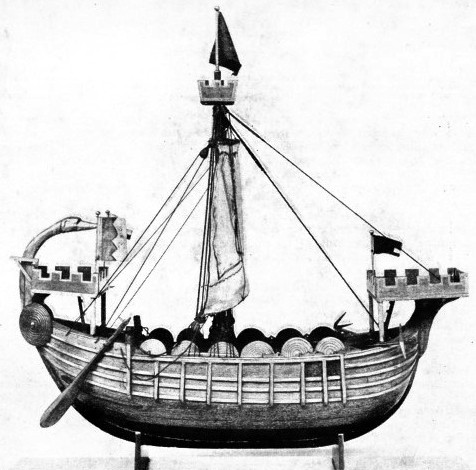
A KING’S SHIP OF THE THIRTEENTH CENTURY. The distinguishing features of ships of this type were the fore and after castles designed for fighting purposes. They were at first temporary structures, but when the English kings started building their own ships instead of hiring merchant vessels, these structures became permanent. The steering paddle was later replaced by a rudder
hung on a stern post.
Among the crew were the boatswain, cook, carpenter and steward. They drank beer and ate bread and meats roasted or boiled; but the unfortunate seasick pilgrims preferred hot malmsey wine and salted toast. Miserable on their first trip down the Bay of Biscay, they would “cowgh and grone”, lose all appetite, and lie down complaining that their heads were split in three. An unpleasant voyage was made little less unendurable by having to sleep on a sack of straw confined within a few cabins roughly knocked together by the ship’s carpenter. Not for many generations was the slightest regard to hygiene paid afloat, and the death rate mounted rapidly only a few days after the vessel had left harbour.
In southern Europe there was greater supervision by the State. Fourteenth-century laws in Venice required that the commanding officer of a merchant galley should be a patrician, and that eight young nobles should accompany such craft to gain an intimate knowledge of ship-handling. They were what we should call apprentices. Every Venetian merchant or mariner who owned a mattress could bring it with him, and the merchant could have also one trunk. Passengers took with them their own wine, food, firewood and cooking utensils. Drinking water was supplied free. They ate salt meat, vegetables, cheese, onions, garlic, biscuits, and flavoured their food with vinegar.
The Italian ship was not allowed to proceed till she had the regulation number of anchors and ropes of the right weight, and she dare not be loaded beyond her marks; yet for the passengers this was no pleasure cruise.
A Crew of Thieves
The crew, engaged from March 1 to the end of November, were paid in advance every three months. They were such thieves, however, that passengers were frequently robbed. Even the spare anchors would be sold at the first port of call. Unless a merchant deposited his gold with the shipmaster, it was more than likely that he would find himself with no money.
In the Middle Ages ships sailed from Venice, Genoa and Pisa bound for Acre. Their merchant passengers were engaged in the Levantine trade of pepper, sugar and silks that had come overland from the Orient. Such was the prevalence of pirates that these mercantile fleets had to be convoyed by fighting galleys. The first convoy from Venice set forth in the spring and reached home in September. The second left the Adriatic in August, and wintered either in Syria or in Egypt, returning home in May.
A considerable passenger trade was created by pilgrims to the Holy Land. They used to embark at Venice, Genoa and Marseilles - the three great ports convenient for northern and central European travellers. Wearied by weeks of land journeying, most of them now saw the sea for the first time. At sea they endured for a period bad food, sour wine, musty drinking water, leaking hulls, a martinet skipper, exposure to burning sun and general dishonesty. The fare during the late fifteenth century varied from 20 ducats (£9) to 55 ducats (£25). From Venice, the route was down the Adriatic, calling at Corfu, Modon (on the south-west coast of Greece), Rhodes, Cyprus and so to Jaffa. Sometimes, however, they never reached their destination, if the skipper decided to pocket the fares and ignore his contracts.
The skipper would sit under his awning at the stern of the two-masted pilgrim galley, a law unto himself. At the bows flew the Jerusalem Cross, with the Lion of St. Mark aft. The horses were stowed in pens just forward of the mizenmast, and died in great numbers from the heat. There was the ever-present possibility of an attack by infidel craft, but at the mainmast head was a topcastle whence darts and missiles could be hurled. At the bows there still survived that obstinate relic of Roman times - the ram and single-fluked grappling anchor for ship-to-ship engagement.
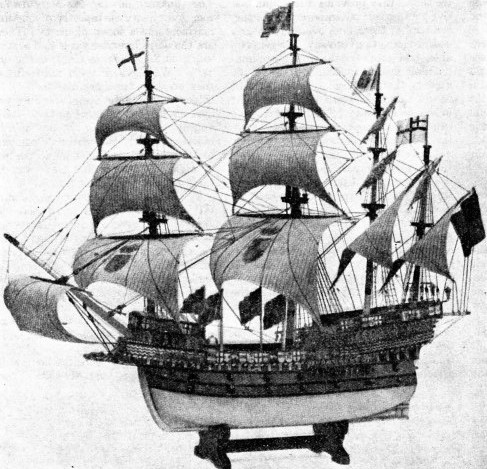
BUILT FOR KING HENRY VIII, the famous Henri Grace a Dieu, shown above in model form, was laid down in 1514 and built near Erith (Kent), on the River Thames. She was regarded as the finest ship of her time, and had a tonnage of about 1,500. She had topgallant sails on fore, main and main-mizenmasts, topsails on the mizen and on what was known as the bonaventure mizenmast.
Before the fifteenth century had closed there had been evolved in the carrack what was to become the standardized big merchant ship for North Sea and Mediterranean cargoes. The carrack was a three-master. Her great height of freeboard gave her a certain independence in Atlantic weather or when attacked by Mediterranean galleys. She was the progenitor of the galleon, and of Nelson’s “wooden walls”. Columbus’s Santa Maria was a carrack of a type that used to sail to and from Flanders loaded with cloth or wine. Because she had to spend so much of her time alongside quays receiving or discharging cargo, the carrack had a hull specially protected by vertical skids and by longitudinal wales or ridges. The carrack’s speed was not excessive, but in the trade winds she could generally do 200 miles in a run of twenty-four hours.
When setting out on a long voyage the ship would be provisioned with wine, corn, salt meat, bacon, biscuit, and also with livestock, sheep, lambs, calves and heifers. On such long trips the navigation was anything but scientific, and especially anxious was the period when land might be sighted. To keep the lookout alert and vigilant, a reward was paid to the man who first sighted the shore. Thus, at the end of weeks spent rolling to the swell, the ship would suddenly become full of excitement, as in one breath the lucky owner of the keenest eyes would claim his reward and announce his discovery. “Largess!” he would shout. “Land in sight! Largess!”
Before the age of discovery could begin it was necessary for some real progress to be made in the study and practice of navigation. The handling of a ship, the steering, the hoisting and trimming of sails, the shortening of sail in bad weather - all these are of great importance. But the knowledge and skill of finding a ship’s position when away from land, laying out the correct courses so that she will eventually make the right landfall after weeks or months at sea - that is navigation, and demands a higher knowledge. When the Middle Ages were ending Europe had thousands of able seamen, but comparatively few navigators. That, was why the revelation of new lands across the ocean had been delayed for so many centuries.
Little does civilization appreciate all that it owes to Prince Henry of Portugal, third son of King John I of Portugal, and nephew of King Henry IV of England. In the year 1415 this intellectual prince withdrew himself from the hurly-burly and attractions of Court life to settle at Sagres, near the bleak and barren promontory of Cape St. Vincent. Here he began to sift all the geographical knowledge accumulated from the ancients. Here were studied mathematics, cartography and astronomy. From Italy and Spain were brought the most experienced navigators of the day. All the travel knowledge that had been picked up from merchants in such markets as London and Bruges was now collected and collated in this international bureau. Hither journeyed also Arabian and Jewish men learned in all that pertained to sun, moon and stars. Instrument-makers, Italian pilots, shipbuilders, sailors - all sorts of experts arrived at this nautical college, so that during the following forty-five years Prince Henry was able to give the marine world the scientific knowledge that was needed for the conquest of unknown seas.
Henry the Navigator
All this research work, the training of navigators, the making of maps and the fashioning of nautical instruments, were the essential preliminaries to the achievements of Vasco da Gama, Magellan and all later maritime explorers. Then this brilliant innovation spread from Portugal to Spain. From Spain it came north to England. It was Charles V who founded at Seville a lectureship in navigation. Henry VIII founded or confirmed at Deptford-on-Thames, Kingston-on-Hull and Newcastle-on-Tyne guilds for the better instruction of English seafarers. From that time began all those more ambitious voyages that culminated in the West Indian expeditions and the East Indian voyages that later led to the foundation of the Honourable East India Company. The medieval ships kept time by hour-glasses, but they had no log for ascertaining speed through the water. Christopher Columbus, was a keen observer and noticed that in certain parts of the ocean there were variations of the compass. He noted also the difference from time to time of the sea’s saltness. Occasionally for three days together he remained on deck, too anxious to sleep. His cabin was on the poop, where he had a bed draped in red, a press for his clothes, a stool, some chairs and a dining-table for two persons. He could not place too much reliance in his helmsmen or in his pilots, or be assured that a smart watch would be kept whenever he turned in for rest. It meant for him weeks of keen anxiety, and in bad weather his carrack rolled so heavily that it was impossible with either astrolabe or quadrant to ascertain the sun’s altitude.
The danger of fire continued to be a perpetual fear. Aboard these ships all lights were forbidden after dark except one for the helmsman, and one below deck carefully protected by a lantern. A bigger lantern was shown over the stern, so that other ships of the squadron could keep the senior vessel in sight through the dark hours. Prayers were said daily, and there were stringent rules against misbehaviour. Apart from Columbus, only the pilots had the slightest knowledge of stellar navigation.
Externally these ships were painted with tar; below water-line the custom was to grease the hull so as to minimize friction. In tidal waters this could be done by beaching the ship, but in the tideless Mediterranean such underbody attention demanded careening, as is still the custom to-day when tartanes (small Mediterranean craft) are painted by their crews. Badly built, with every detail of the roughest, the medieval vessels leaked notoriously. Writing of his fourth voyage, Columbus has left it on record that he started out “with the ships rotten, worm-eaten”, and “pierced with worm-holes, like a bee-hive”. In that condition these vessels crossed the Atlantic twice.
O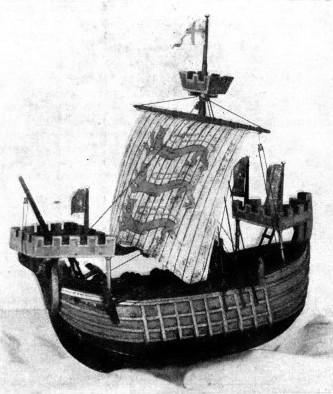 nly their admirable enterprise, bravery in the face of every discouragement, could have made these medieval mariners willing to leave the security of their home.
nly their admirable enterprise, bravery in the face of every discouragement, could have made these medieval mariners willing to leave the security of their home.
EARLY SHIPS OF THE THIRTEENTH CENTURY had a form of bowsprit that served not only to support a small grapnel, but also where possible to give a longer lead to the bowlines. Until rudders came to be used instead of steering paddles, the bows of these King’s ships did not differ greatly from the sterns.
You can read more on “First Voyage Round the World”, “Instruments of Navigation” and
“Ships in Miniature” on this website.







 nly their admirable enterprise, bravery in the face of every discouragement, could have made these medieval mariners willing to leave the security of their home.
nly their admirable enterprise, bravery in the face of every discouragement, could have made these medieval mariners willing to leave the security of their home.